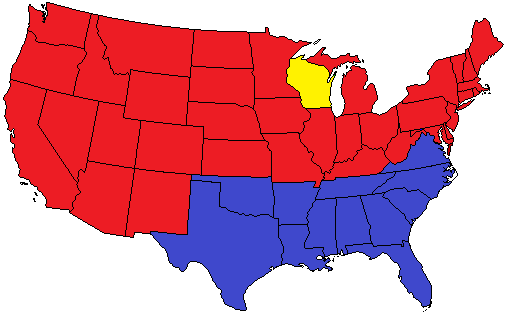 1924 election;
1924 election;
red = Republican, blue = Democrat, yellow = Progressive Party
Where the once solidly Democratic South is concerned, the above map of the 1924 election results would be just as appropriate for any presidential contest from 1880 to 1944, save for 1928 when the disastrous combination of New York governor Al Smith’s Roman Catholicism and anti-prohibitionist sentiments left the Democrats with but 87 electoral votes (16.4 percent) to call their own. Yet the six southern states that held firm in the Democratic column accounted for three fourths of that total, and although Smith could not even carry his own state, he actually captured more than 90 percent of the vote in South Carolina and more than 80 percent in Mississippi.1
Although the Democrats had been widely regarded as the unflinching guardians of southern white interests since the end of Reconstruction, relations with the national party had begun to fray just a bit by the end of the 1930s. Determined that their constituencies would get their share of desperately needed federal largesse, southern politicians had maintained a somewhat apprehensive but superficially friendly relationship with President Franklin Roosevelt’s New Deal until the second half of the 1930s. The agenda of the national Democratic Party had begun to show more of a northern orientation, however, in response to the demands of both organized labor and African Americans who had left the South in the millions during the previous two decades and given Roosevelt the majority of their votes in 1936. In that same year, the Democrats had dropped their requirement that the party’s presidential nominee receive at least two thirds of the delegate vote, a move that effectively stripped Southerners of their power to veto any candidate who truly displeased them, especially one who seemed the least bit inclined to interfere in southern racial affairs. Increasingly frustrated by what he saw as judicial and congressional efforts to derail the New Deal, FDR had frightened some white southerners when he sought the power to appoint additional justices in order to liberalize the Supreme Court through his ill-fated 1937 “court-packing” plan. When he moved the following year to unseat certain conservative Democrats in the South in his equally ill-considered “purge” campaigns, the New Deal’s unlikely marriage of convenience with white southern conservatives definitely began to unravel.
With the return of relative prosperity during World War II, the need for Washington’s assistance was not so urgent, and southern Democrats like Senator James O. Eastland of Mississippi quickly served notice that they were prepared to make a stand in defense of their region’s racial and political hierarchy. Anti-Roosevelt insurgencies broke out in Texas, Mississippi, and South Carolina in 1944, and rather than endorse FDR, disenchanted delegates from seven southern states cast a total of eighty-nine votes for Senator Harry F. Byrd of Virginia at the party’s convention, where southerners also led the successful charge to replace liberal vice-presidential incumbent Henry A. Wallace on the ticket with a presumably more conservative Senator Harry S. Truman of Missouri (Bartley 87–93).
Most southern Democrats would soon be lamenting their support for Truman as Wallace’s replacement, however. As FDR’s successor, not only did he appoint a high-profile President’s Committee on Civil Rights, but after some deliberation he endorsed the committee’s extensive recommendations for federal action against racial discrimination on an expanded front. In 1948 Truman issued executive orders ending segregation in the armed forces and forbidding racial discrimination in government hiring. When Hubert Humphrey, the mayor of Minneapolis, delivered an impassioned speech on behalf of the party’s pro-civil rights stance delegates from Alabama and Mississippi walked out of the national convention. This move led ultimately to a meeting in Birmingham, where disaffected southern Democrats formed the States’ Rights Democratic Party, known popularly as the “Dixiecrats,” and chose J. Strom Thurmond, governor of South Carolina, as their presidential candidate, with Governor Fielding Wright of Mississippi as his vice-presidential running mate.
That the disgruntled southerners who refused to support the national Democratic ticket and platform called themselves States’ Rights Democrats was no accident. Their strategy centered on gaining control of southern state Democratic organizations in order to have their candidates designated on the ballot, not as the standard-bearers of a third party, but as the duly ordained representatives of the Democratic Party within each state. Ultimately the Dixiecrats managed to pull this off only in Alabama, Mississippi, South Carolina, and Louisiana, and these were also the only states they were able to carry come election time. Listed on the ballot only as a third party they captured 20 percent of the vote in Georgia but less than 10 percent in North Carolina and Texas.
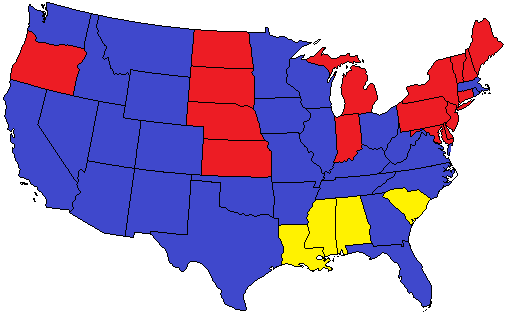
1948 presidential election;
blue = Democrat, red = Republican,
yellow = “Dixiecrat” (State’s Rights Democrat)
Overall the Dixiecrat ticket of Thurmond and Wright collected more than a million votes, showing its greatest strength in counties with large concentrations of nonvoting blacks that were dominated by the white elites whose interests and ideas the Dixiecrats most clearly represented. Because of their hostility to organized labor they also drew strong support from representatives of some southern businesses and industries intent on keeping unions out and wages low. Although the Dixiecrats’ message generally did not resonate quite so well among other whites in metropolitan and small farming areas, their constituency would be in the front ranks of a once-unthinkable exodus of southern whites to the Republican Party sixteen years later (Bartley 87–93).
The Dixiecrats had set out to demonstrate the Democratic Party’s political dependence on white southerners. In the end Truman’s rather surprising reelection may have suggested that their efforts fell short, but their insurgency was nonetheless a sobering testament to how frayed the party fabric had become as a result of just a few preliminary efforts to address some of the nation’s racial wrongs. In 1952, several notable southern Democratic leaders either endorsed Republican Dwight D. Eisenhower or offered what was at best halfhearted support for their party’s nominee, Illinois Governor Adlai E. Stevenson. En route to a sweeping nationwide triumph, Eisenhower captured Virginia, Tennessee, Florida, and Texas, three of which were on the periphery of the South and all of which were home to substantial, relatively affluent, well-educated metropolitan populations likely to find the fiscal conservatism of the Republicans appealing. In the long run, Eisenhower’s victory in the states probably reflected a combination of lingering animosity over the Democrats’ pro-civil rights stance in 1948 and the emergence of a business-oriented middle class comfortable with the traditional values espoused by the Republicans (Bartley 94–95).
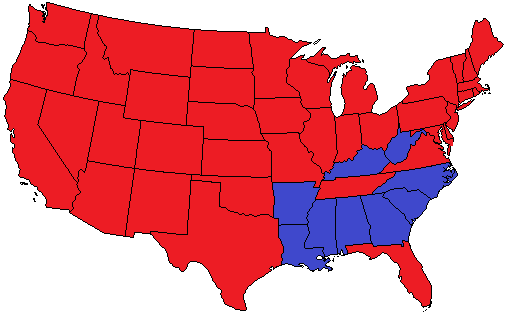
1952 presidential election;
blue = Democrat, red = Republican.
Four years later, the Republicans managed not only to hold on to the states they had captured in 1952, but to pick up Louisiana, which had the largest urban population in the Deep South. Eisenhower’s southern support tailed off only in Mississippi and South Carolina, where many voters blamed the 1954 Brown vs. Board of Education desegregation ruling on his appointment of Earl Warren as Chief Justice of the Supreme Court. Adlai Stevenson was once again the Democrats’ choice and, although he tried to dance around the question, southern whites in general seemed to think that he would actually be more inclined to enforce the Brown decision than Eisenhower, who had made no secret of his sympathy for southern whites and distaste for the Court’s decree. Had Eisenhower’s reluctant decision to send federal troops to restore the peace during the Little Rock integration crisis in 1957 come a year earlier, his appeal to Southern whites would doubtless have been diminished.
By 1960, white Southerners had satisfied themselves that they could support a Republican for president while continuing to vote for Democrats in state and local races, and GOP nominee Richard M. Nixon became his party’s first standard-bearer to campaign in every southern state. Hoping to counter the effect of choosing New Englander and Roman Catholic John F. Kennedy to head their ticket, the Democrats made Texan and former Senate Majority Leader Lyndon B. Johnson his running mate. At this point, Eisenhower owned responsibility for the Brown decision and the intervention in Little Rock, and as vice president, Nixon had actually become the administration’s spokesperson / advocate for civil rights.
Although he had scant credentials as a civil rights proponent, Kennedy promised “moral leadership” on the issue, and his running mate was deemed a “turncoat” by many southern whites upset that Johnson had accepted the strong civil rights agenda laid out in the Democratic platform. At that point, blacks accounted for less than 10 percent of the region’s registered voters, and contrary to the national pattern, they had continued to give the majority of their support to the party of Lincoln. Moreover, no less thoroughly Protestant than their white neighbors, many black voters were also skeptical of supporting a Roman Catholic for president. Kennedy finally seemed to nose ahead of Nixon with black voters by placing a timely phone call to Coretta Scott King when her husband was imprisoned in Georgia on a trumped up charge, thereby securing the support of the Rev. Martin Luther King, Sr., who switched his allegiance from Nixon and used his considerable influence to get out the black vote for the Democrats. In the end, Kennedy carried every southern state except Virginia, Tennessee and Florida, which he lost to Nixon, and Mississippi where he ran second to a slate of “unpledged electors,” who wound up voting for Virginia segregationist Harry F. Byrd. There was little question that Lyndon Johnson’s presence on the ticket played the key role in bringing Texas back to the Democratic column in 1960 (Black and Black, Vital South 189–99).
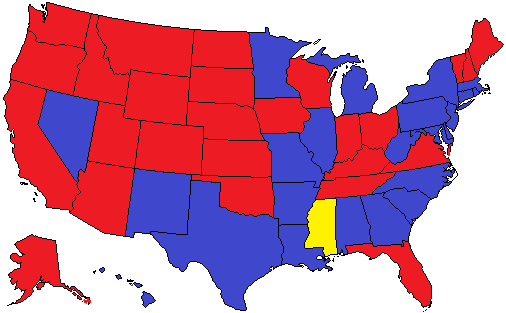
1960 presidential election;
blue = Democrat, red = Republican,
yellow = voted for the segregationist Senator Harry F. Byrd.
Although Nixon had come up a bit short of Eisenhower’s totals in 1956, it was nonetheless clear that the Democratic grip on the South was nothing like what it had been prior to 1948, and even though Kennedy still managed to claim 52 percent of the region’s white votes, this would mark him as the last Democratic presidential candidate to date who has secured a white majority in the South. Indeed, events during Kennedy’s less than three years in office would help to set the stage for an abrupt and enduring break that would soon make the old “solid” Democratic South seem but a distant memory. The controversy surrounding the sit-in protests and the Freedom Rides, and the Kennedy administration’s reluctant use of federal troops to quell the violence at Ole Miss in 1962 and compel the integration of the University of Alabama in 1963 had won the national party few friends among southern whites. When Lyndon Johnson took up the cause of the sweeping new civil rights bill introduced by JFK some five months before his assassination in November 1963 and pushed it through Congress the following summer, his political instincts told him that his party had “lost the South for a generation.” Johnson’s estimate proved conservative, to say the least.
The ascendant darling of the Republican Party’s right wing, Arizona senator Barry Goldwater had been a favorite of southern whites since he expressed reservations about the Kennedy administration’s handling of the Ole Miss integration crisis in 1962, and Goldwater’s vote against the Civil Rights Act of 1964 clearly had done nothing to diminish his stature in diehard segregationist circles. As the Republican presidential nominee in 1964, Goldwater made good on his vow to “go hunting where the ducks are” by courting southern whites who were disenchanted with the Democratic Party’s pro-civil rights stance, and he did so openly and blatantly, while showing not so much as a pretense of interest in winning black support. Thus, he effectively got none while amassing huge white majorities in areas where substantial black populations had yet to be enfranchised by the Voting Rights Act that would come the following year.
The counties of the southern black belt, home to the South’s most racially conservative whites and large numbers of unregistered blacks, had given 58 percent of their votes to the Democratic Kennedy in 1960 only to go for Republican Goldwater by a slightly higher proportion four years later. Where blacks could vote, the outcome was stunning in its racial polarity. Goldwater averaged over 90 percent in Jackson, Mississippi’s white precincts and over 80 percent in Mobile, Alabama, where, on the other hand, he received less than 1 percent of the black vote. Overall, he racked up white majorities in every southern state except Lyndon Johnson’s Texas. In dragging Alabama, Georgia, Louisiana, Mississippi, and South Carolina into the Republican column (all save Louisiana for the first time since Reconstruction), Goldwater had also helped to elect seven new GOP congressmen from the Deep South, five of them from Alabama alone (Bartley and Graham 106–108).
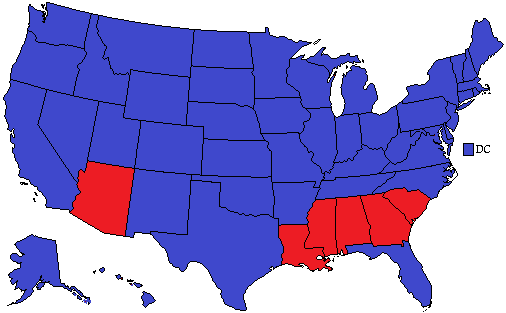
1964 presidential election; blue = Democrat, red = Republican
As the 1968 campaign approached, the Republicans seemed poised to expand on Barry Goldwater’s five-state Deep South breakthrough in 1964, but where Alabama’s segregationist governor George C. Wallace had been forced to abandon his presidential bid four years earlier, he was now in the race as the candidate of the American Independent Party and committed not only to sweeping the South but to making a race of it nationally as well. As of September, Wallace had exploited “white backlash” against the Civil Rights movement outside the South into a 20 percent standing in national polls, and many believed that he might deny Nixon any of the old Confederate states. Meanwhile, the GOP strategy seemed to be simply conceding the Deep South states that had gone to Goldwater in 1964 to Wallace, save for South Carolina, where the old-Dixiecrat-now-Republican senator Strom Thurmond was expected to hold the Palmetto State for his new party. Otherwise, the Nixon plan was to contest the border South states by avoiding the bluntly anti-black, anti-civil rights rhetoric of Goldwater while still making it abundantly clear to apprehensive white parents that a Nixon administration would oppose “forced busing” to achieve school integration.
As he pursued southern delegates at the GOP convention, Nixon indicated that he would take a minimalist approach to enforcing pro-civil rights court decisions and be in no hurry to “satisfy some special civil rights group or something like that.” In the waning days of the campaign, by reiterating his lack of enthusiasm for implementing such rulings, Nixon forced Democratic nominee Hubert H. Humphrey to reaffirm his promise to enforce them fully and vigorously. This undercut Wallace’s contention that there wasn’t “a dime’s worth of difference” between the candidates of the two major parties and demonstrated why white southerners should think twice about voting for Wallace, lest they wind up electing Humphrey (“Nixon is hard to fathom” 21; Carter 329).
In the end, Nixon captured seven southern states, all of them, save South Carolina, in the upper South. Wallace racked up a majority of the votes in Alabama and Mississippi and carried Arkansas, Georgia, and Louisiana as well. Humphrey was a pariah to southern whites, including many Democratic politicos, but owing to the influence of the abdicating Lyndon Johnson, he narrowly bested Nixon in Texas. Overall, Nixon captured 36 percent of the southern popular vote compared to 33 percent for Wallace and 31 percent for Humphrey, whose totals proved a remarkably close approximation of black turnout. Nationally, Wallace finished with 13.5 percent of the vote, with more than half of his ten million ballots coming from the South (Bartley 379).
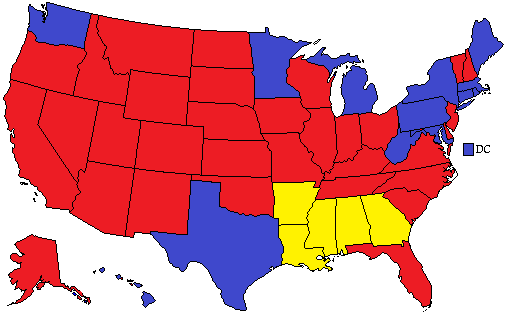
1968 presidential election;
blue = Democrat, red = Republican,
yellow = voted for the candidate of the American Independent Party, George C. Wallace
Political analyst Kevin Phillips saw the 1968 election as the harbinger of “a new American Revolution” driven by an “emerging Republican majority” that would be fueled by middle- and lower-middle-class whites in the South and West. In positioning himself as a more moderate and responsible alternative to Wallace, Nixon’s immediate aim had been to capture the votes of suburban upper-South whites nervous about busing and urban violence, but likely to be a bit uncomfortable with Wallace’s outright segregationism and crude threats to run down anti-war protestors who tried to block his way. Once in office, Nixon continued to pursue this “southern strategy” by suggesting that white southerners were being singled out unfairly to bear the burden of school integration: “Let’s just stop this hypocrisy that the problem in our schools is only in the South. . . . The time has come to quit jerking the South around.” Such rhetoric, coupled with Nixon’s attempt to stack the Supreme Court with conservative justices who exhibited little enthusiasm for judicial activism on civil rights, counted for a great deal with southern white voters who supported him overwhelmingly against his hapless Democratic challenger George McGovern in 1972 (Chester 627; Lassiter 267).
With the shadow of the Watergate scandal hanging over the 1976 presidential election and former Georgia governor Jimmy Carter bidding to become the first president from the Deep South since Woodrow Wilson, the Democrats seemed to have their best chance since the 1940s to reunite the old Solid South. Accordingly, they rolled out a “southern strategy” of their own. In essence, it consisted simply of holding together the combination of blacks, blue-collar whites, and a significant minority of upper-income whites that had fueled the victories of Carter and other moderate southern Democratic congressional and gubernatorial candidates in 1970. As a fiscally conservative Southern Baptist who had announced the end of racial discrimination in Georgia and hung a portrait of the Rev. Martin Luther King, Jr., in the Georgia state capitol, Carter was peculiarly equipped to execute this strategy, and he did so to near-perfection. To be sure, Carter’s cause benefited significantly from his unelected incumbent opponent Gerald R. Ford’s pre-emptive pardon of Richard Nixon, who had resigned in the face of his certain impeachment and possible removal from office in the wake of Watergate. An ineffective campaigner at best, Ford had been hampered further by an economic slowdown in the months before the election as well as by a convention challenge from rising right-wing star Ronald Reagan.
Still, as Carter’s campaign manager Hamilton Jordan explained at the outset, his chances depended on
[t]he southern states [which] provide us with a base of support that cannot be taken for granted or jeopardized. . . . The Republicans cannot win if they write off the South.
The essence of Carter’s southern strategy became apparent when he sought and won the simultaneous endorsement of the Rev. Martin Luther King, Sr., and Alabama Governor George Wallace. Showing an agility and flexibility as a candidate that he would often seem to lack as president, Carter maintained his ties to blacks while simultaneously pursuing the Wallace vote at every opportunity, even claiming a special affinity with NASCAR fans and showing up to ride the track at the annual Darlington 500 race. At a rally in Birmingham, Carter paid tribute to a beaming Governor Wallace, who sat on the platform in his wheelchair while Carter asserted, “We Southerners believe in work, not welfare” and promised to balance the federal budget without undermining a strong national defense. In response, Wallace confessed with what seemed genuine fervor, “Oh, how I have longed to see a Deep Southerner like you and me and Jimmy Carter in the White House” (Black and Black, Vital South 330–32).
As he campaigned, Carter did not hesitate to appeal to white southerners’ sense of grievance and pride. One television spot announced that
on November 2, the South is being readmitted to the Union. If that sounds strange, maybe a southerner can understand. Only a southerner can understand years of coarse, anti-southern jokes and unfair comparisons. Only a southerner can understand what it means to be a political whipping boy. But, then, only a southerner can understand what Jimmy Carter as President can mean.
Texas-born writer Larry King captured the significance of Carter’s candidacy for millions of white southerners when he simply exulted, “We Ain’t Trash No More!” Upon encountering Carter’s armor of southern honor and pride, Republican charges that he was an “ultraliberal” or merely a “Southern-fried McGovern” seemed to glance harmlessly away (Black and Black, Vital South, 332–34; King 88).
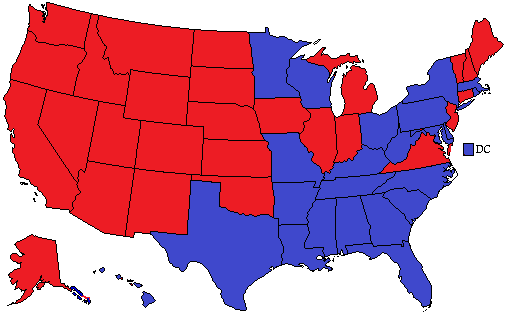
1976 presidential election;
blue = Democrat, red = Republican.
In the end, Carter bested Ford by 2 percent of the popular vote, winning by 57 electoral votes after picking up 118 of the requisite 270 in the South, but failing by 1.3 percent of the vote in Virginia to bring the Old Dominion back into the Democratic fold. It was telling, however, that, even running against a white southerner, his Republican opponent had captured some 54 percent of the white vote in the region. What proved to be the last gasp of southern Democratic unity faded quickly in response to the multitude of woes ranging from runaway inflation to high energy costs to the Iranian hostage crisis that combined to cripple the Carter presidency. Cheered by the prospect of having one of their own in the White House, nearly two-thirds of Southern Baptists had supported Jimmy Carter against Gerald Ford in 1976, but Republican challenger Ronald Reagan would claim nearly half their votes four years later as an embattled Carter, already under attack for his handling of the hostage fiasco, also drew a withering fire from television evangelist Rev. Jerry Falwell’s recently organized “Moral Majority” for his stance on issues like abortion and gay rights (Carter 47).
Reagan seemed ready simply to pick up where the Nixon administration’s “southern strategy” of appealing to white southerners’ racial resentments had left off when he opened his 1980 presidential campaign in Neshoba County, Mississippi, the site of the brutal 1964 slayings of three civil rights workers. Offering a spirited defense of “states’ rights,” Reagan’s kickoff speech resurrected the racially coded rhetoric of the massive resistance era, and his pet campaign story about a “welfare queen” who supposedly had fleeced the government for $150,000,000 a year was hardly short on racial overtones. A Reagan advisor remarked that
obviously sitting around saying, “We want to cut this,” is much more abstract than even the busing thing and a hell of a lot more abstract than “Nigger, nigger.”
Therefore, all Reagan had to do was “run in place on the issues he’s campaigned on since 1964 . . . fiscal conservatism, balancing the budget, cut taxes, you know, the whole cluster” (Lamis 26).
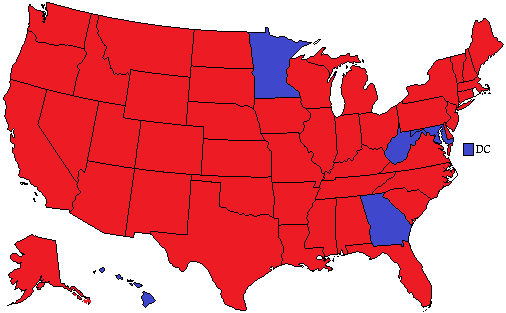
1980 presidential election;
blue = Democrat, red = Republican
After outdistancing Carter in every southern state save his native Georgia, Reagan’s first term showcased his commitment to the “whole cluster,” and his hostility to affirmative action, indifference to voting rights enforcement, and opposition to stripping all-white private schools of their tax-exempt status more than adequately affirmed and clarified his racial stance. This much was apparent in the racially polarized voting patterns in 1984 that saw a triumphant Reagan claim an estimated 86 percent of the white vote in Mississippi, while his Democratic challenger collected 89 percent of the black vote. Across the South, only 9 percent of all the ballots cast by blacks went to Ronald Reagan. Reagan’s conservative economic stance doubtless contributed to his 77 percent showing among southern whites with incomes above $35,000, but given his opposition to wage hikes and other pro-labor policies, it was hard to see what, other than Reagan’s across-the-board hostility to any programs seen as favorable to blacks, may have helped him capture 56 percent of the votes among southern whites with incomes less than $15,000 (Lamis 238–40).
Across the South, southern Republicans claimed nine new House seats in 1984, bringing them up to 37 percent of the region’s total. Meanwhile, after the elections, Republicans occupied 21 percent of the seats in southern legislatures, a 4 percent increase from 1982. Until the 1964 Goldwater campaign the Republicans had been the moderate alternative to Democratic conservatism in southern politics. When Reagan left office some twenty-five years later the GOP was the conservative alternative to Democratic moderation. Under Reagan the party had solidified its “natural” southern white-collar suburban base while securing and extending Goldwater’s and Nixon’s inroads among rural blue-collar whites. The most telling illustration of the Reagan era’s impact on southern politics may be that whereas only 40 percent of southern white conservatives identified themselves as Republicans in 1980, by 1988 that figure stood at 60 percent. Reagan’s congeniality, charm, and personal political skills doubtless played a key role in accelerating this transformation, but the more fundamental elements of the Republican Party’s appeal for southern whites included its staunchly conservative positions on race, taxes, welfare, anticommunism, and moral and religious issues such as abortion and prayer in schools (Lamis 249–50; Black and Black, Southern Republicans 222; Aistrup 51).
Eagerly donning the Reagan mantle, his vice president George H. W. Bush had no problem sweeping the South in his contest with the liberal Democrat governor of Massachusetts, Michael Dukakis. Although his successful conduct of “Operation Desert Storm” against Iraq in 1991 made him quite popular among southern militarists, Bush’s national fortunes began to plummet during the final months leading up to the 1992 election. The Republican right took none too kindly to Bush’s decision to pull the apparently winning issue of opposition to racial quotas off the campaign strategy table for 1992, and he had already infuriated a great many conservatives by reneging on his 1988 “Read my lips, no new taxes” pledge when he agreed to a budget compromise arrangement in 1990. With the nation sliding into an economic recession and his support crumbling badly, Bush’s team made a desperate attempt to reach out to the far right by giving them a prominent role in writing the 1992 platform, which included a proposed ban on all abortions, even in cases of rape and incest. At the convention itself prime-time speeches by Pat Buchanan and Rev. Pat Robertson conveyed the image of a party dominated by right-wing ideologues (Karst 29).
Meanwhile, for the Democrats, former Arkansas governor Bill Clinton hammered the hapless Bush relentlessly on the economy while portraying himself as a “New Democrat,” more centrist than liberal, committed to welfare reform (a traditional hot-button Republican issue) and to a new national health care plan geared to help the middle class as well as the poor. Many pundits questioned Clinton’s political wisdom in choosing a fellow southerner, Tennessee senator Al Gore, as his running mate, but en route to victory the “Bubba Squad” succeeded in carrying their home states as well as Georgia and Louisiana, all of which had gone to Bush by more than 60 percent of the vote in 1988.
Ultimately these states were not crucial to Clinton’s win, for his was a truly national triumph, albeit one facilitated significantly by third-party candidate Ross Perot’s appeal to disaffected Republicans across the country. There was also widespread dissatisfaction with Bush’s failure to address the nation’s economic problems, as well as concern among centrist swing voters that in catering to evangelicals and anti-abortion activists the Republicans themselves had swung too far to the right. This trend was readily observable in the South when Bush, who had polled 59 percent of the moderate white vote in 1988, managed only 41 percent from the same group in 1992. Bush barely bested Clinton in this category, but among southern whites overall the Democratic victor received only an estimated 35 percent of the vote, scarcely three points better than either Mondale or Dukakis had done in 1984 and 1988, respectively (Black and Black, Southern Republicans 220, 30).
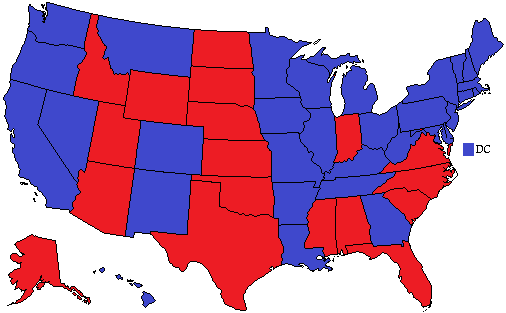
1992 presidential election; blue = Democrat, red = Republican
Clinton again carried four southern states when he won reelection in 1996, losing Georgia (where he actually polled a higher percentage of the vote than when he won in 1992 but got less help from Perot’s presence on the ballot this time around) but picking up Florida. Once again, although they were not critical to his victory, the key to Clinton’s success in these states was his appeal to white moderates, whom he courted with a somewhat more conservative stance than he had taken four years earlier, including his support for a tough crime bill and for tighter restrictions on welfare eligibility. The air strikes he ordered against the Serbs in Bosnia in 1995 had given the impression of a more confident foreign policy leader, and although an off-year election trouncing in 1994 had seen Republicans seize control of both houses of Congress, the incumbent president ultimately benefited from a rebounding economy, declining interest rates, and a shrinking federal deficit.
Stepping up to claim the Democratic presidential nomination in 2000, Vice President Al Gore could invoke a strong economy as he did battle with a supposedly overmatched Texas governor George W. Bush. On the other hand, the second Clinton term had brought revelations of an extraordinarily reckless extramarital dalliance in the White House that then led to a highly partisan impeachment trial, both of which seemed ultimately to damage Gore more than Clinton. White voters in the South and elsewhere tended to vote for or against Gore on the basis of their feelings about Clinton, many of them refusing to credit Gore for Clinton’s economic accomplishments while nonetheless associating him with the president’s sexual indiscretions.
Although some observers doubted that the stiff and wonkish Gore would do as well with black voters, who had all but idolized Clinton, in capturing 91 percent of southern black votes, the vice president actually posted a stronger showing with blacks than his former boss did. Yet Gore garnered less than 39 percent of the white vote in his home state of Tennessee, compared to the 43 percent that went to Clinton in 1996. Gore suffered another, even more dramatic falloff in white support in ultimately decisive Florida, the only southern state where the third-party candidacy of consumer advocate Ralph Nader actually affected what would be at best a truly questionable outcome. Nader’s candidacy would not have mattered in 2000, however, had Bush not picked off 16 percent of the Florida whites who had voted for Clinton in 1996. Wooden and unspontaneous in comparison to his gregarious and relaxed opponent, Gore bore the burden of association with Clinton, and his encyclopedic grasp of facts and ideas actually seemed to hurt him with some white voters who saw him as much more of the aloof, technocratic Democratic liberal than the folksy but informed Clinton had been. Across the South Bush bested Gore by two to one among whites, capturing all of its 160 electoral votes, which amounted to 60 percent of his winning total. Thus, ironically, he became both the first Republican presidential candidate since 1972 to sweep the South and the only one since 1968 whose victory depended on the support of a single southern state (Stanley 219–31).
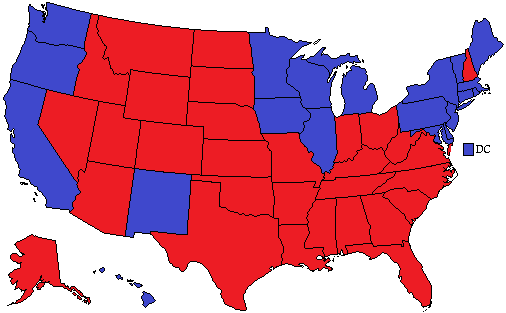
2000 presidential election; blue = Democrat, red = Republican.
Bush’s decision to invade Iraq in 2003 had begun to cost him in national polls by 2004. However, he remained in good standing with typically pro-military, religiously conservative southern whites who also approved of his stances against abortion and gay marriage. Running against Democratic Senator John Kerry of Massachusetts in 2004, Bush again swept the South, improving significantly on his 2000 showing with southern white voters by capturing 85 percent of their support in Mississippi and 80 percent in Alabama and claiming from 64 to 78 percent in all the remaining southern states except Florida (57 percent). Kerry came close to equaling Gore’s performance with southern black voters, but despite having the military record that his opponent lacked, his eventual opposition to the Vietnam War and his image as a traditional “tax-and-spend” northern liberal who often seemed Brahminesque and ill-at-ease with the common folk proved his undoing with southern whites (“Decisions 2004”).
The ideological divide between the parties was less pronounced farther down the ticket, but even during the Clinton presidential interregnum of the 1990s the Republicans had continued to claim a progressively greater share of congressional- and state-level offices. Some of these gains came from party-switching; fifteen of the twenty-five congressmen who changed their partisan affiliations between 1980 and 2005 were from the South. Beyond that, after picking up nine southern seats in the 1994 election surge that brought them control of Congress for the first time since 1952, the Republicans had improved their standing in the House of Representatives with each election over the next decade. By virtue of rapid population growth the South had gained a net of thirteen seats, courtesy of the 1990 and 2000 censuses, and the Republicans had gone from holding 40 percent of the region’s House seats and 35 percent of its Senate seats in 1992 to controlling 57 percent of its House seats and 92 percent of its Senate seats by 2004 (“Just how bad off is the Republican Party?”).
With the national outcry over the war in Iraq growing louder and Bush’s popularity faltering nationwide, the GOP lost six southern seats in the House and one in the Senate in 2006. Two of the House losses were virtually unwinnable situations for the Republicans after a lobbying scandal toppled the former House majority leader Tom Delay of Texas and a sex scandal involving a House page forced Florida’s Congressman Tom Foley from office. The new Democratic Senate seat came in Virginia, where former Republican Jim Webb bested incumbent George Allen after Allen’s campaign stumbled in the wake of his reference to an Indian American supporter of his opponent as “macaca,” a term sometimes used to refer to a genus of monkey. Overall, however, with the old Confederacy giving Democrats only 15 percent of their congressional, gubernatorial, and legislative gains, the South was most notable in 2006 for its relative resistance to national trends.
Democrats obviously hoped to turn their 2006 breakthrough into a trend in 2008, but their prospects for actually making inroads within Dixie itself seemed to evaporate when Senators Hillary Clinton and Barack Obama emerged as the frontrunners for the party’s presidential nomination. White southerners had obviously shown little receptivity to the vice-presidential candidacy of Geraldine Ferraro in 1984 or, for that matter, to the idea of any woman holding the highest office in the land. Needless to say, as an African American, Obama’s chances in the South seemed even slimmer than Clinton’s.
Ironically, however, although the South would not prove critical to his victory in November, primary voters in a number of southern states actually helped to propel Obama to his party’s nomination. With overwhelming support from blacks and a surprising share of the white vote as well, he bested Clinton in the North Carolina and Virginia primaries and in every Deep South Democratic contest except Florida, where he did not campaign. A number of the South’s veteran black political leaders were initially inclined toward Clinton, who they believed would be more electable, but Obama’s early primary successes soon brought most of them around. Obama’s strength among blacks was hardly unexpected, but white southern Democrats were generally seen as the party’s most conservative adherents. Yet generally Obama ran at or slightly better than his poll-based projections among white Democrats in the South, while frequently falling short of those numbers in primaries outside the region.
Although the principal concern among Obama’s supporters in the final stages of both the primaries and the general election campaign would be whether he could overcome the doubts of white Democrats elsewhere in the nation, at the outset there was no getting around the fact that the majority of white southerners had not voted even for a white Democrat in a presidential election since 1960. Accordingly, when America’s first black major party presidential nominee began his general election campaign against the former P.O.W. and staunchly pro-military Arizona senator John McCain, few gave him much chance down in the race- and defense-conscious South. Even with an expected increase in black turnout it was hard to imagine that Obama could prevail against the intensified white resistance that a black Democratic candidate was sure to arouse. This scenario ultimately played out in Alabama, where exit polls suggested that Obama had picked up only 10 percent of the white vote as compared to the 19 percent that went to John Kerry in 2004. In Mississippi Obama claimed only 11 percent of white votes, compared to 14 percent for Kerry, and in Louisiana, Kerry’s 24 percent showing among whites dipped to 14 percent for Obama (American Votes 2004).
Across the region, however, Obama not only equaled or surpassed Kerry’s share of the white vote in nine of thirteen states, but utilizing hordes of volunteers and drawing on a huge campaign war chest he was able to break the GOP’s chokehold on Dixie by winning Florida, Virginia, and North Carolina. He captured these states by getting a significantly greater percentage of white votes in North Carolina and Virginia and matching Kerry’s share of the white vote in Florida, while running five to ten points ahead of Kerry with black voters as well. Excluding Oklahoma, where no data were available, if exit polls are to be believed, Obama averaged approximately 96 percent of the black vote across the southern states, and within states he typically ran strongest in places with large black populations and in fast-growing metropolitan areas like North Carolina’s Research Triangle, home to large numbers of younger, more affluent, better educated residents, both white and black (“Exit Polls” 2008).
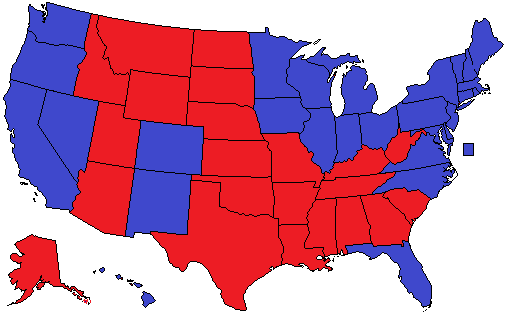
2008 presidential election; blue = Democrat, red = Republican.
The patterns of support for Obama also reflected the growing suburbanization of the South’s black middle class. He carried three relatively close-in metropolitan Atlanta counties—Douglas, Newton, and Rockdale—that, after giving 60 percent or more of their votes to Bush in 2004, had seen their black populations more than double since 2000. Blacks represented over one-third of the population in each of these counties by 2008, and although McCain carried four other nearby metropolitan counties with smaller but fast-growing black and Hispanic populations (including notoriously conservative Cobb), his share of the vote in these counties nonetheless fell short of Bush’s in 2004 by seven to twelve points. The limits of the Democrats’ surge in metro Atlanta were sharply defined by race and geography, however. In the adjoining metropolitan counties Walton, Forsyth, and Cherokee, which were both whiter and farther out from Atlanta, McCain claimed better than three of every four votes cast (“Are Atlanta’s Suburbs Turning Blue?”).
A number of observers wondered whether either charges that Hillary Clinton was the victim of sexism during her primary campaign or the mere fact of Sarah Palin’s presence on the Republican ticket might affect the voting patterns of white women in 2008. In the South, of course, the historic tensions over white women’s relationships and interactions with black men added yet another dimension. Nationwide, exit polls indicated that 46 percent of white women’s votes had gone to Obama. Although Florida was the only southern state where he came within ten points of that figure among white women, as he had done with white men in the trio of southern states he carried, Obama equaled Kerry’s 2004 performance with white women in Florida and improved on it significantly in North Carolina and Virginia. By the same token, in Alabama and Louisiana, where Obama’s white support generally fell well below Kerry’s, white women rejected him in roughly the same percentages as white men did. Meanwhile, despite concerns that Hispanics would not support a black candidate, where Kerry had won 44 percent of the Hispanic vote in Florida and 50 percent in Texas, Obama bested him by 13 percentage points in both states (“Exit Polls” 2008).
By bringing out record numbers of black voters the Obama campaign obviously boosted the fortunes of a number of white Democratic candidates elsewhere on the ticket. Black votes helped former governor Mark Warner claim Virginia’s second Senate seat for the Democrats. In Georgia, despite capturing less than 30 percent of the white vote, Democratic senatorial challenger Jim Martin was able to force a runoff with GOP incumbent Saxby Chambliss because blacks gave him 93 percent of their support. In North Carolina, neither the Democratic senatorial candidate Kay Hagan nor her gubernatorial counterpart, Beverly Perdue, won as much as 40 percent of the white vote, but with 96 and 95 percent of the black vote, respectively, both managed victories on election night.
It was tempting in some respects to interpret the Democratic triumphs in North Carolina, Florida, and Virginia as evidence that some parts of the South might be trending, if not “blue,” at least a little “purple.” However, the surprising news that a number of whites in these states apparently had not found Obama too liberal might have obscured the possibility that his victories actually owed something to other whites who actually found both Obama and his opponent too liberal, or at least in the latter case, too centrist, to suit them. McCain’s support for a path to citizenship for illegal immigrants and his somewhat fuzzy position on abortion rendered him fairly suspect among voters on the far right, regardless of region, and compared to 2004 the GOP turnout was down 1.3 percent across the country in 2008. In light of the anticipated white backlash against the Obama camp’s massive voter registration effort, it was surprising that the Republican total in Virginia was essentially flat compared with 2004. Meanwhile, twenty-five thousand North Carolinians supported Libertarian Bob Barr in a state where the Obama victory margin was fewer than fourteen thousand votes.
If McCain’s appeal seemed a bit tepid among some white voters in the South, there were also a great many who made no secret of their distaste for Obama and, in some cases at least, made little effort to conceal the racist attitudes behind it. Overall only 22 percent of the counties nationwide voted more strongly Republican in 2008 than in 2004, and some three-fourths or more of them were in the South. In general the populations of these predominantly rural, sparsely populated counties tended to be whiter, poorer, less educated, and more evangelical than their peers elsewhere in the region. The South could claim practically all the counties where the Republicans gained an additional 10 percent or more of the vote in 2008 than in 2004, and one-third of the residents of these counties were Southern Baptists (“For South, a Waning Hold on National Politics”).
Those who argued that the 2008 race showed once and for all that Democrats should stop wasting their time on the South in presidential elections seemed to see the entire region as simply one of these counties—Lamar County, Alabama (total vote, 7,075), for example—writ large. When the New York Times’s Adam Nossiter wrote that McCain’s 90 percent showing among whites in Alabama was “comparable to other Southern states,” he neglected to mention that this was actually true only for Mississippi and Louisiana and that, save for Arkansas, Obama had equaled or improved on Kerry’s percentages among whites even in the remaining southern states where he lost. In fact when Nossiter pointed out that “less than a third of southern whites voted for Obama compared to 43 percent of whites nationwide,” he was actually saying nothing more than that, save for Bill Clinton, a black candidate had run about as well as or better among white southerners than any other Democratic presidential nominee since Jimmy Carter. Moreover, though there was no disputing Obama’s stronger overall showing among whites in other parts of the country, had it been solely up to the majority of white voters in seven of the states he carried outside the South (including New Jersey, Pennsylvania, Ohio, and Indiana), his electoral margin over McCain would have shrunk from 192 to 18. Certainly Nossiter’s suggestion that the South had forfeited much of its influence on national affairs by “leaving the mainstream so decisively” in 2008 bears rethinking in light of the 2010 congressional races that saw the Republicans pick up 45 of their 67 new House seats outside the region. (“For South, a Waning Hold on National Politics”; “Exit Polls”; Decision 2008).
Apparently oblivious to geographic and historical realities (not to mention the pitfall of tautologous reasoning) other pundits have effectively suggested that the very fact of Obama’s victories in Florida, North Carolina, and Virginia showed that these states were no longer really “southern.” Yet, although they were not really necessary for an Obama victory in 2008, the fifty-five electoral votes the Democrats picked up in these three states are hardly to be sneezed at in most presidential contests. Elsewhere, in Georgia, where McCain’s final five-point margin was much slimmer than anticipated, the Obama campaign’s belated decision to run spots targeting metro Atlanta, with its large population of white newcomers and African Americans, might have indicated recognition of a lost opportunity and foretold a more formidable future effort in that state. This would appear to make sense since Georgia (+1) and Florida (+2) both stand to gain electoral votes after the 2010 census. In Florida’s case, two additional votes will actually make it as valuable a prize as New York, which is slated to lose two, while Texas, which admittedly presents a much stiffer challenge for the Democrats, will pick up four new electors, making it as big a prize as Ohio and Pennsylvania combined (Kromm 2009).
On the other hand, in the short term at least, the Democrats seemed unlikely to invest major time or resources campaigning in electorally puny states like Alabama, Mississippi, Louisiana, or South Carolina, where generally hard-line white attitudes not only on race but on religion and other social issues gave little indication of softening anytime soon. Likewise, much like the Democrats during most of the first two decades after World War II when they could still take a “Solid South” largely for granted, so long as their opponents left these states uncontested in presidential elections, the Republicans may have no particular incentive to pay much attention to them either.
Certainly there was still good reason for the GOP to feel secure in the South, where, as of 2011, the party controlled 22 of the region’s 26 Senate seats and 102 of its 142 seats in the House. It was particularly telling that only 19 of the remaining 40 southern Democrats in the House were white. In state politics, only Alabama, Mississippi, and South Carolina had boasted Republican governors in 1992. Despite some power shifts to and fro in the interim, by 2011 the only southern states with Democratic governors were Arkansas, North Carolina, Kentucky and Virginia. Likewise, in the South’s state legislatures, the best the Republicans could claim in 1992 was a split with the Democrats in the Florida State Senate. Even with some Democratic resurgence, after the 2010 elections the GOP enjoyed a numerical advantage in both legislative chambers not only in Florida, but in Alabama, Georgia, Oklahoma, South Carolina, Tennessee, and Texas, while not a single southern state legislature was still entirely under Democratic control (Lawrence).
Barack Obama’s victories in Virginia, North Carolina, and Florida and apparent inroads in the metropolitan areas of other southern states may well be a glimpse into the future, although not necessarily the immediate one. Continuing patterns of southward black migration, primarily to major metropolitan areas like Atlanta (which, according to the 2010 census, has now supplanted Chicago as the nation’s second largest black population center after New York City) will doubtless strengthen the Democrats’ position in the region somewhat. The same is likely true of a Hispanic growth rate that roughly tripled that for blacks during the last decade. It remains to be seen, however, whether in the short term Hispanics will either register or actually turn out to vote in numbers likely to make them a true political force in states other than Florida and Texas.
In a very real sense, the long-term meaning of the last presidential election for southern politics depends mightily on whether we see sustained black political participation at the level of 2008, when blacks accounted for approximately 13 percent of the total vote in the South. As many observers predicted, without a black man running for president, black turnout slipped noticeably in the midterm elections of 2010, when blacks were responsible for just 10 percent of the southern votes cast. Presuming that Barack Obama will be at the head of his party’s ticket in November 2012, at this point there is certainly reason to wonder whether he will stir as much excitement among black voters as he managed to generate four years earlier. Beyond that, it is surely no stretch to say that without a decided upturn in the economy at the very least, he will be hard-pressed to equal the support that he claimed from southern whites in 2008. By the same token, polls consistently showing white Southerners among the groups most hostile to Obama and his policy initiatives such as health care reform, not to mention surveys showing the South to be a hotbed of “birthers,” who even challenge the president’s claims to citizenship, give little reason to think that his opposition in the region will be any less rabidly committed than they were during his first campaign. In short, it is too soon even to hazard a guess whether Obama’s achievement in capturing three states for the Democrats represents the actual beginning of a trend away from nearly half a century now of Republican preponderance in the South or merely the suggestion of such possibility for the future. The best indication, after all, of what any single election may mean lies in the outcome of the next one (“Birther”).
Works Cited
Aistrup, Joseph A. The Southern Strategy Revisited: Top-Down Republican Party Development in the South. Lexington: University Press of Kentucky, 1996.
America Votes 2004. “U.S. President/National/Exit Poll.” CNN.com. 2005. 20 Nov. 2011 <http://www.cnn.com/ELECTION/2004//pages/results/states/US/P/00/epolls.0.html>.
“Are Atlanta’s Suburbs Turning Blue?” Atlanta Journal–Constitution, 9 Nov. 2008: A–1.
Bartley, Numan V. The New South, 1945–1980. Baton Rouge: Louisiana State University Press, 1995.
——, and Hugh Davis Graham. Southern Politics and the Second Reconstruction. Baltimore: John Hopkins University Press, 1975.
Black, Earl and Merle Black. The Vital South: How Presidents Are Elected. Cambridge: Harvard University Press, 1992.
——, and Merle Black. The Rise of Southern Republicans. Cambridge: Belknap Press of Harvard University, 2003.
“‘Birther’ phenomenon strong in the rural South, pollsters find.” Facing South. 2010. 20 Nov. 2011 <http://www.southernstudies.org/2009/08/birther-phenomenon-strong-in-the-rural-south-pollsters-find.html>.
Carter, Dan T. The Politics of Rage: George Wallace, The Origins of the New Conservatism, and The Transformation of American Politics. Baton Rouge: Louisiana State University Press, 1996.
Carter, Stephen L. God’s Name in Vain: The Rights and Wrongs of Religion in Politics. New York: Basic Books, 2000.
Chester, Lewis, Godfrey Hodgson, and Bruce Page. American Melodrama: The Presidential Campaign of 1968. New York: Viking, 1969.
“Exit Polls.” 2008. MSNBC.com. 20 Nov. 2011<http://www.msnbc.msn.com/id/26843704/>.
“Exit Polls.” 2004. MSNBC.com. 20 Nov. 2011 <http://www.msnbc.msn.com/id/5297118/>.
“For South, a Waning Hold on National Politics.” New York Times 11 Nov. 2008.
“General Election, Votes Cast, Percent Republican, 2008.” Georgia Statistics. 20 Nov. 2011 <http://www.georgiastats.uga.edu/>.
“Just How Bad Off Is the Republican Party (Part 2)?” Salon. 18 Mar. 2009. 20 Nov. 2011 <http://www.salon.com/news/feature/2009/03/18/state_of_the_gop/>.
Karst, Kenneth L. Law’s Promise, Law’s Expression: Visions of Power in the Politics of Race, Gender, and Religion. New Haven: Yale University Press, 1995.
King, Larry. “We Ain’t Trash No More!” Esquire 126 (1976): 88.
Kromm, Chris. “A New South Rising.” Facing South. 2008. 20 Nov. 2011 <http://www.southernstudies.org/2008/11/analysis-a-new-south-rising.html>.
Lamis, Alexander P. Two-Party South. 2nd ed. New York: Oxford University Press, 1990.
Lassiter, Matthew D. The Silent Majority: Suburban Politics in the Sunbelt South. Princeton: Princeton University Press, 2007.
Lawrence, Julie. “GOP Wave of Change Hits House; Republicans Also Gain Governorships.” Politics Daily. 2 Nov. 2010. 20 Nov. 2011 <http://www.politicsdaily.com/2010/11/02/2010-midterm-elections-news-and-results/>
“Nixon Is Found Hard to Fathom on Basis of Public Statements.” New York Times 26 Oct. 1968.
Stanley, Harold W. “The South in the 2000 Elections.” The 2000 Presidential Election in the South: Partisanship and Southern Party Systems in the 21st Century. Ed. Robert P. Steed and Laurence W. Moreland. Westport: Praeger, 2000. 219–230.
“The South Just Isn’t What It Was.” St. Petersburg Times 25 Jan. 2009. 20 Nov. 2011 <www.tampabay.com/news/perspective/article969751.ece>.
Notes
Author
Suggested Citation

This work is licensed under a Creative Commons Attribution-ShareAlike 3.0 Unported License.


